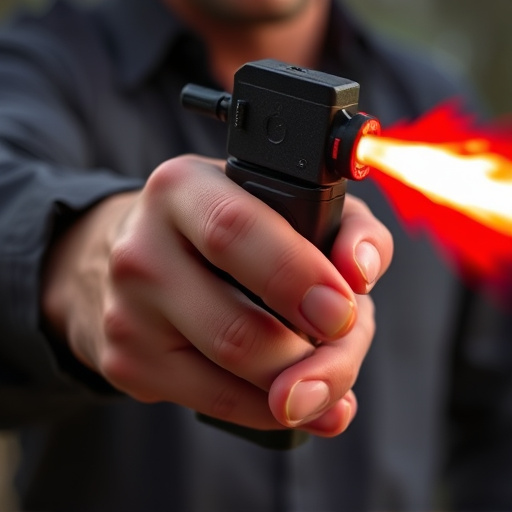Learn essential pepper spray decontamination steps at home for enhanced safety. Remove contaminated clothing, wash hands and create a decon area with a plastic tarp. Mix white vinegar and warm water in a spray bottle to clean the device. Store decontaminated pepper spray in a sealed container away from heat and sunlight. Best practices include keeping it cool, dry, secure and using an airtight container. After each use, clean the nozzle with distilled water, avoid harsh chemicals or abrasives. Store the device upside down to drain residual liquid and reduce degradation risk.
“Personal protection devices, particularly pepper spray, offer crucial defense in potential threatening situations. However, understanding the science behind chemical irritants like capsaicin, the active ingredient in pepper spray, is key to effective decontamination and longevity of your equipment. This article explores ‘Pepper Spray Decontamination Steps at Home’, providing a comprehensive guide for proper decontamination techniques and best storage practices.”
- Understanding Chemical Irritants: The Science Behind Pepper Spray
- Decontaminating Your Personal Protection Devices at Home: Step-by-Step Guide
- Best Practices for Safe Storage and Longevity of Pepper Spray Equipment
Understanding Chemical Irritants: The Science Behind Pepper Spray
Chemical irritants, like pepper spray, have become an integral part of personal protection devices for individuals seeking to safeguard themselves in various scenarios. Understanding the science behind these irritants is crucial when considering their use and decontamination steps at home. Pepper spray, a common chemical irritant, contains capsaicin, the active ingredient found in chili peppers. When sprayed, it stimulates nerve endings in the eyes, nose, and respiratory system, causing temporary disorientation and difficulty breathing.
The decontamination process for pepper spray exposure at home involves several steps. Firstly, move to an area with fresh air immediately. Remove any contaminated clothing and wash affected areas with soap and warm water. Rinsing thoroughly with water helps dilute the chemical. In case of eye contact, flush gently with water for at least 15 minutes. Seeking medical attention is recommended if symptoms persist or are severe. Additionally, keeping a supply of pepper spray and knowing basic decontamination techniques can be vital for personal safety in unexpected situations.
Decontaminating Your Personal Protection Devices at Home: Step-by-Step Guide
To decontaminate your personal protection devices, like pepper spray, at home, start by removing any accessible clothing or items that might have come into contact with the chemical irritant. Next, thoroughly wash your hands with soap and warm water for at least 20 seconds to prevent accidental exposure.
Create a decontamination area using a plastic tarp or drop cloth to contain any potential spills. Mix a solution of one part white vinegar and one part warm water in a spray bottle. Spray the mixture onto the pepper spray device, letting it sit for several minutes to help break down the irritant. Use a soft-bristled brush to gently scrub away residual chemicals. Rinse the device with clean water and dry it thoroughly using a microfiber cloth or paper towels. Finally, store your decontaminated pepper spray in a sealed container at room temperature, out of direct sunlight and away from heat sources.
Best Practices for Safe Storage and Longevity of Pepper Spray Equipment
To ensure the safety and effectiveness of pepper spray equipment, it’s crucial to follow best practices for storage and longevity. Start by keeping the device in a secure, cool, dry place, away from direct sunlight and heat sources. This prevents damage from extreme temperatures, which can degrade the chemical components over time. Consider using an airtight container or pouch designed specifically for storing pepper spray to minimize exposure to moisture, dust, and other contaminants that might reduce its potency.
Additionally, regular decontamination steps at home are essential. After each use, clean the nozzle and any visible parts with a soft cloth dampened in distilled water. Avoid using harsh chemicals or abrasive materials that could damage the equipment or alter the spray’s composition. Store the device upside down to allow any residual liquid to drain out, further minimizing the risk of degradation. Following these simple yet effective practices will help maintain your pepper spray equipment for optimal performance when needed.
Understanding the science behind pepper spray and implementing proper decontamination steps at home are essential practices for ensuring the effectiveness and longevity of your personal protection devices. By following these simple yet crucial Pepper Spray Decontamination Steps, you can maintain a reliable self-defense tool, ready for when you need it most. Remember, staying prepared is key to staying safe.
